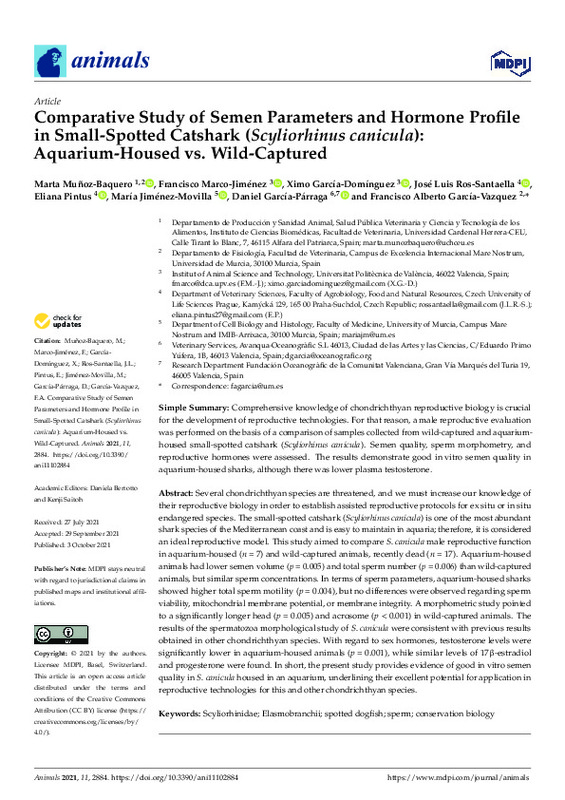JavaScript is disabled for your browser. Some features of this site may not work without it.
Buscar en RiuNet
Listar
Mi cuenta
Estadísticas
Ayuda RiuNet
Admin. UPV
Comparative Study of Semen Parameters and Hormone Profile in Small-Spotted Catshark (Scyliorhinus canicula): Aquarium-Housed vs. Wild-Captured
Mostrar el registro sencillo del ítem
Ficheros en el ítem
| dc.contributor.author | Muñoz-Baquero, Marta
|
es_ES |
| dc.contributor.author | Marco-Jiménez, Francisco
|
es_ES |
| dc.contributor.author | Garcia-Domínguez, Ximo
|
es_ES |
| dc.contributor.author | Ros-Santaella, José Luis
|
es_ES |
| dc.contributor.author | Pintus, Eliana
|
es_ES |
| dc.contributor.author | Jiménez-Movilla, María
|
es_ES |
| dc.contributor.author | García-Párraga, Daniel
|
es_ES |
| dc.contributor.author | García-Vazquez, Francisco Alberto
|
es_ES |
| dc.date.accessioned | 2022-05-24T18:04:50Z | |
| dc.date.available | 2022-05-24T18:04:50Z | |
| dc.date.issued | 2021-10 | es_ES |
| dc.identifier.uri | http://hdl.handle.net/10251/182864 | |
| dc.description.abstract | [EN] Comprehensive knowledge of chondrichthyan reproductive biology is crucial for the development of reproductive technologies. For that reason, a male reproductive evaluation was performed on the basis of a comparison of samples collected from wild-captured and aquarium-housed small-spotted catshark (Scyliorhinus canicula). Semen quality, sperm morphometry, and reproductive hormones were assessed. The results demonstrate good in vitro semen quality in aquarium-housed sharks, although there was lower plasma testosterone. Several chondrichthyan species are threatened, and we must increase our knowledge of their reproductive biology in order to establish assisted reproductive protocols for ex situ or in situ endangered species. The small-spotted catshark (Scyliorhinus canicula) is one of the most abundant shark species of the Mediterranean coast and is easy to maintain in aquaria; therefore, it is considered an ideal reproductive model. This study aimed to compare S. canicula male reproductive function in aquarium-housed (n = 7) and wild-captured animals, recently dead (n = 17). Aquarium-housed animals had lower semen volume (p = 0.005) and total sperm number (p = 0.006) than wild-captured animals, but similar sperm concentrations. In terms of sperm parameters, aquarium-housed sharks showed higher total sperm motility (p = 0.004), but no differences were observed regarding sperm viability, mitochondrial membrane potential, or membrane integrity. A morphometric study pointed to a significantly longer head (p = 0.005) and acrosome (p = 0.001) in wild-captured animals. The results of the spermatozoa morphological study of S. canicula were consistent with previous results obtained in other chondrichthyan species. With regard to sex hormones, testosterone levels were significantly lower in aquarium-housed animals (p & LE; 0.001), while similar levels of 17 beta-estradiol and progesterone were found. In short, the present study provides evidence of good in vitro semen quality in S. canicula housed in an aquarium, underlining their excellent potential for application in reproductive technologies for this and other chondrichthyan species. | es_ES |
| dc.language | Inglés | es_ES |
| dc.publisher | MDPI AG | es_ES |
| dc.relation.ispartof | Animals | es_ES |
| dc.rights | Reconocimiento (by) | es_ES |
| dc.subject | Scyliorhinidae | es_ES |
| dc.subject | Elasmobranchii | es_ES |
| dc.subject | Spotted dogfish | es_ES |
| dc.subject | Sperm | es_ES |
| dc.subject | Conservation biology | es_ES |
| dc.subject.classification | PRODUCCION ANIMAL | es_ES |
| dc.subject.classification | BIOLOGIA ANIMAL | es_ES |
| dc.title | Comparative Study of Semen Parameters and Hormone Profile in Small-Spotted Catshark (Scyliorhinus canicula): Aquarium-Housed vs. Wild-Captured | es_ES |
| dc.type | Artículo | es_ES |
| dc.identifier.doi | 10.3390/ani11102884 | es_ES |
| dc.rights.accessRights | Abierto | es_ES |
| dc.contributor.affiliation | Universitat Politècnica de València. Departamento de Ciencia Animal - Departament de Ciència Animal | es_ES |
| dc.description.bibliographicCitation | Muñoz-Baquero, M.; Marco-Jiménez, F.; Garcia-Domínguez, X.; Ros-Santaella, JL.; Pintus, E.; Jiménez-Movilla, M.; García-Párraga, D.... (2021). Comparative Study of Semen Parameters and Hormone Profile in Small-Spotted Catshark (Scyliorhinus canicula): Aquarium-Housed vs. Wild-Captured. Animals. 11(10):1-14. https://doi.org/10.3390/ani11102884 | es_ES |
| dc.description.accrualMethod | S | es_ES |
| dc.relation.publisherversion | https://doi.org/10.3390/ani11102884 | es_ES |
| dc.description.upvformatpinicio | 1 | es_ES |
| dc.description.upvformatpfin | 14 | es_ES |
| dc.type.version | info:eu-repo/semantics/publishedVersion | es_ES |
| dc.description.volume | 11 | es_ES |
| dc.description.issue | 10 | es_ES |
| dc.identifier.eissn | 2076-2615 | es_ES |
| dc.identifier.pmid | 34679905 | es_ES |
| dc.identifier.pmcid | PMC8532847 | es_ES |
| dc.relation.pasarela | S\446638 | es_ES |








